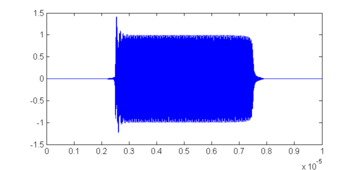Radiofrequency pulse
From NMR Wiki
Radiofrequency pulse or "RF pulse" is a temporary burst of radio waves which serves as a basic element of any pulsed NMR experiment.
Below is an approximate image of a realistic square 5μs long pulse. Notice that edges of the pulse are not perfect. There is an oscillation of amplitude in the beginning and a somewhat gradual falloff at the end of the pulse. Typically such transient imperfections on the modern hardware are or the order of ~100 ns (nanosecond is 10-9 seconds)
The "inner" portion of the pulse is filled with the radio-frequency oscillation. That frequency in the NMR literature is called "carrier frequency" and is most often kept constant throughout the experiment (however hardware allows re-setting that frequency during the course of the pules sequence).
Duration of that burst is called "pulse width", typically abbreviated as PW.
Strength of the pulse is more commonly measured in Hertz as 1/(4*PW90), where PW90 is the duration of 90o pulse at the same power.


